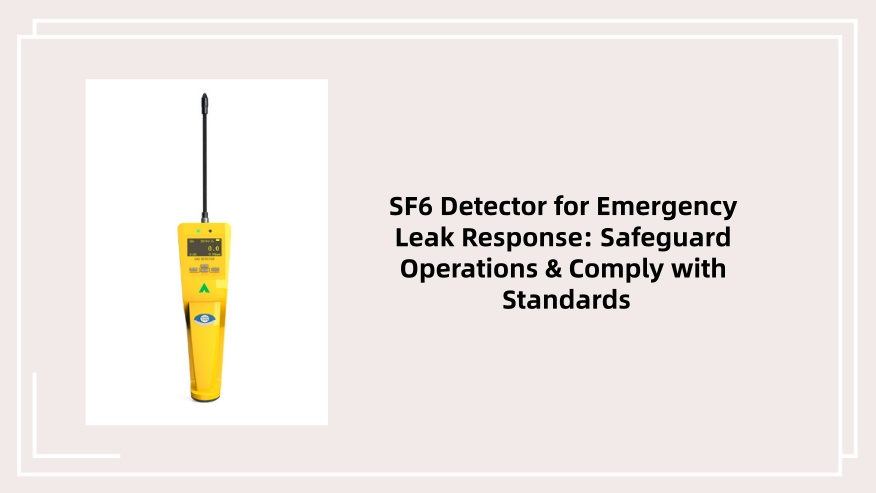
- SF6 Relations
- 2025-09-17
SF6 (sulfur hexafluoride) is a critical insulating gas in high-voltage electrical equipment—from GIS (gas-insulated switchgear) to transformers—thanks to its excellent dielectric and arc-quenching properties. However, SF6 is a potent greenhouse gas (23,500 times more impactful than CO₂ over 100 years) and poses health risks when leaked: its heavy, odorless nature traps air in confined spaces, causing asphyxiation, while high-temperature decomposition produces toxic byproducts like hydrogen fluoride (HF) and sulfur dioxide (SO₂). In emergency leak scenarios, every minute counts—and a reliable SF6 detector for emergency leak response becomes the first line of defense to protect personnel, minimize environmental damage, and avoid operational downtime.
Why Emergency Leak Response Demands a Specialized SF6 Detector
Ordinary gas detectors often fail in SF6 emergency scenarios, making a purpose-built SF6 detector for emergency leak response non-negotiable. Here’s why:
First, SF6’s high density (5 times heavier than air) means leaks settle in low-lying areas (e.g., equipment basements, cable trenches) rather than dispersing. Generic detectors, designed for lighter gases, may miss these localized pockets, leading to delayed alerts. Second, emergency leaks require speed: a quality SF6 detector for emergency response delivers response times under 10 seconds, compared to 30+ seconds for general-purpose devices—critical when personnel need to evacuate or isolate the leak source quickly. Third, toxic decomposition byproducts demand multi-sensor capability: top-tier SF6 detectors for emergency use include dual sensors to detect both SF6 and its harmful byproducts, eliminating blind spots in risk assessment.
Core Features of an Effective SF6 Detector for Emergency Leak Response
To perform in high-stakes emergency scenarios, an SF6 detector for emergency leak response must prioritize four key features:
- High Sensitivity & Accuracy: Look for detectors with a detection range of 0-1000 ppm (parts per million) and a lower detection limit (LDL) of ≤1 ppm. This ensures even minor leaks (common in aging equipment) are caught before they escalate.
- Portability & Durability: Emergency response teams move across job sites—detectors should be lightweight (≤1.5 kg), IP65-rated for dust/water resistance, and operable in extreme temperatures (-20°C to 50°C) to withstand outdoor or industrial environments.
- Real-Time Data & Alerts: Audible (≥85 dB), visual (LED flashes), and vibrating alerts ensure visibility in noisy substations. Built-in LCD screens display real-time SF6 concentrations, while Bluetooth/Wi-Fi connectivity lets teams share data remotely for coordinated response.
- Long Battery Life: Emergency leaks may require hours of monitoring—detectors with 8+ hours of continuous use (and rechargeable lithium-ion batteries) avoid power failures mid-operation.
How to Choose the Right SF6 Detector for Emergency Leak Response
Not all SF6 detectors are equal—focus on these criteria to align with emergency needs:
- Compliance with Standards: Opt for detectors certified to IEC 61779-4 (for SF6 gas monitoring) and OSHA/EN safety standards, ensuring accuracy and regulatory compliance.
- Byproduct Detection: Select models with integrated HF/SO₂ sensors to address both SF6 leaks and toxic decomposition risks, avoiding the need for multiple devices.
Ease of Use: Emergency situations leave no time for complex setup—detectors with one-button operation, auto-calibration, and intuitive menus reduce training requirements for on-site teams. - Calibration Support: Look for brands offering field calibration kits or annual service plans; uncalibrated detectors lose accuracy, rendering them useless in emergencies.
Real-World Applications of SF6 Detectors for Emergency Leak Response
The value of a SF6 detector for emergency leak response shines in high-risk industries:
- Power Substations: When a GIS unit develops a sudden leak, technicians use portable SF6 detectors to map leak zones, evacuate non-essential staff, and deploy gas recovery systems—preventing extended outages that disrupt electricity grids.
- Renewable Energy Facilities: Wind turbine transformers and solar inverters using SF6 rely on emergency detectors to address leaks in remote locations, where delayed response could lead to costly equipment damage.
- Industrial Plants: Manufacturing facilities with SF6-insulated equipment use fixed SF6 detectors (paired with portable units for emergency response) to monitor confined spaces, ensuring compliance with environmental regulations like the EU’s F-Gas Regulation.
In SF6 emergency leak scenarios, the difference between a safe resolution and a crisis lies in the right equipment. A specialized SF6 detector for emergency leak response doesn’t just meet regulatory requirements—it protects lives, reduces environmental impact, and keeps critical operations running. When selecting a detector, prioritize speed, sensitivity, durability, and compliance to ensure your team is prepared for the unexpected. By investing in a reliable SF6 detection solution, you turn emergency challenges into manageable situations—securing your operations today and tomorrow.
Leave a Reply